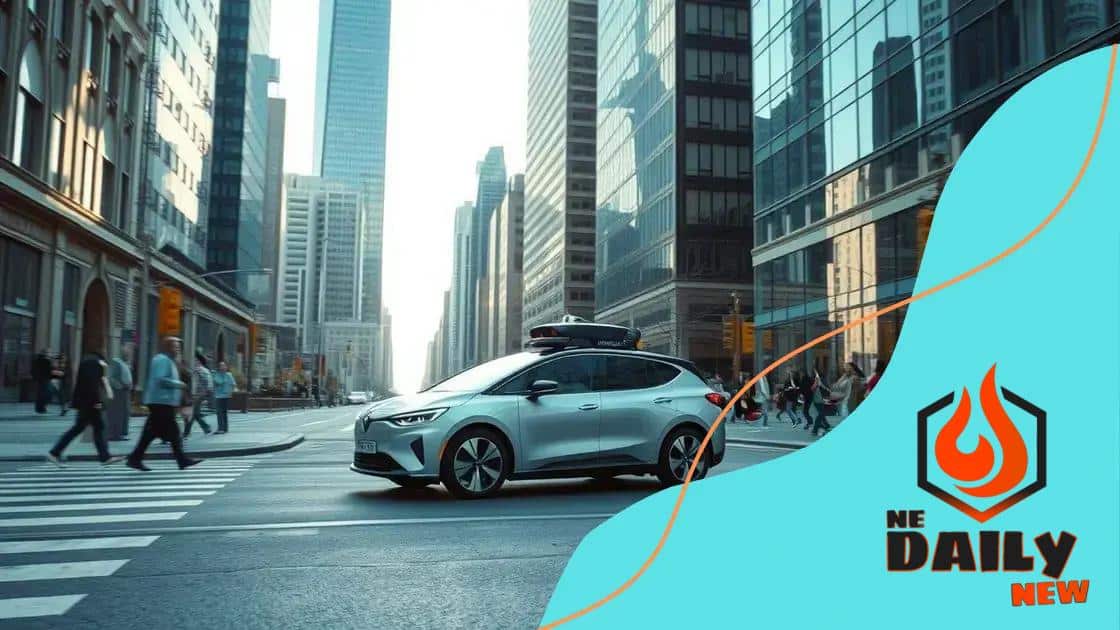How autonomous vehicles are reshaping urban transport

Autonomous vehicles are reshaping urban transport by improving traffic efficiency, reducing emissions, and prompting necessary infrastructure changes, while also addressing safety concerns and enhancing public perception.
How autonomous vehicles are reshaping urban transport is a topic that many of us are curious about. Just think about how these technologies are gradually changing our daily commutes and the very fabric of our cities. Let’s explore what this means for the future.
Understanding autonomous vehicles
Understanding autonomous vehicles is vital as they become more prevalent in our cities. These vehicles rely on advanced technologies to navigate without human intervention. But what exactly makes them work? Let’s break it down.
Key Technologies Behind Autonomous Vehicles
Several technologies contribute to the operation of self-driving cars. They include sensors, machine learning, and real-time data processing. These components work together to ensure that the vehicle can understand its surroundings and react accordingly.
- Sensors: These capture data about the environment.
- Machine Learning: This enables cars to learn from experiences.
- Real-time Data: Vehicles rely on current traffic information.
- Navigation Systems: These help in mapping out routes efficiently.
With these technologies, autonomous vehicles can detect obstacles, recognize traffic signals, and make decisions based on their environment. This leads to safer driving conditions and efficiency in urban transport.
Benefits of Autonomous Vehicles
Using these innovative vehicles in urban areas has profound benefits. They can help reduce traffic congestion, lower emissions, and improve road safety. Imagine cities where traffic flows smoothly, and accidents are significantly lower. Wouldn’t that be an ideal situation?
Autonomous vehicles also promise to enhance accessibility for those who may not drive, such as the elderly or disabled. This opens up new possibilities for independent travel.
As cities adapt to these changes, infrastructure will need to evolve too. We may see changes in road designs and transportation policies to accommodate the rise of self-driving technology. Overall, understanding autonomous vehicles and their benefits is crucial for embracing the future of urban transport and ensuring it is effective and safe for everyone.
The impact on traffic efficiency
The impact of autonomous vehicles on traffic efficiency is a topic that draws significant interest. With their advanced technology and ability to communicate with each other, these vehicles can transform our roads into safer and more organized spaces. Imagine a world where traffic jams become a thing of the past!
Reducing Traffic Congestion
One of the most notable effects of self-driving cars is their potential to reduce traffic congestion. Through constant data exchange and route optimization, these vehicles can adjust their paths in real-time. This means they can find the quickest and least congested routes, avoiding unnecessary delays.
- Real-time communication: Autonomous vehicles can share information about road conditions.
- Adaptive routing: They dynamically change their paths based on traffic levels.
- Coordinated movement: This helps minimize stop-and-go situations.
- Smart intersections: Future traffic signals may adapt to traffic flow.
As autonomous vehicles become more integrated into our urban infrastructure, we can expect to see smoother traffic patterns. This adaptability showcases their ability to lessen the burden on our roads.
Enhancing Fuel Efficiency
Another major impact of self-driving technology lies in improving fuel efficiency. By optimizing routes and maintaining consistent speeds, these vehicles can help save fuel and reduce greenhouse gas emissions. Drivers using autonomous vehicles can experience a more economical ride.
Imagine cars that can communicate to avoid excessive idling at traffic lights or find the best speeds to maintain while merging onto highways. This technology not only benefits the environment but also reduces costs for vehicle owners.
With the evolution of autonomous vehicles, the dream of more efficient traffic systems becomes increasingly achievable. The combination of innovation and adaptability may lead to a future where urban transport is not only more efficient but also more enjoyable.
Safety concerns and public perception

Safety concerns and public perception are critical factors in the acceptance of autonomous vehicles. Many people feel apprehensive about the idea of letting a machine drive them. Understanding these fears is essential for addressing public doubts.
Understanding Public Concerns
One of the main concerns regarding self-driving cars is safety. People often worry about the technology’s ability to prevent accidents. Fatalities in early tests have heightened these fears, leading many to question whether it’s safe to trust a car without a human driver.
- Technological reliability: How often do these systems fail?
- Accident statistics: Are autonomous vehicles statistically safer?
- Human error: Can machines eliminate mistakes made by human drivers?
- Public opinion: What do people believe about the safety of these vehicles?
Addressing these concerns requires transparency from manufacturers, showcasing how autonomous vehicles can actually enhance safety through advanced technology. These cars can react faster than humans and are equipped with multiple safety features.
Shaping Public Perception
Public perception can significantly influence how quickly self-driving technology is implemented. Education plays a vital role in shaping opinions and ensuring that individuals understand the benefits and capabilities of these vehicles.
As manufacturers and governments promote safety initiatives, more people may begin to trust this technology. Factors like public demonstrations and transparent communication can effectively reduce fears and build confidence. Integrating educational programs will help familiarize the public with the technology.
By addressing safety concerns head-on and promoting awareness, we can pave the way for a smoother acceptance of autonomous vehicles. The conversation around safety and public perception will only grow as this technology becomes more mainstream, reshaping urban transport as we know it.
Environmental benefits of self-driving cars
The environmental benefits of self-driving cars are significant and can contribute to a more sustainable future. As cities are looking for ways to reduce pollution and improve air quality, these vehicles offer promising solutions.
Reduced Emissions
One of the main advantages of autonomous vehicles is their potential to lower carbon emissions. By optimizing driving patterns and reducing unnecessary idling, these cars can decrease fuel consumption. Improved fuel efficiency means fewer greenhouse gases are released into the atmosphere.
- Efficient driving: Self-driving cars maintain optimal speeds, reducing fuel usage.
- Eco-friendly routes: They can choose paths with less traffic and fewer stops.
- Less congestion: With fewer cars on the road, emissions can decrease.
- Electric models: Many autonomous vehicles are designed to be electric, further lowering emissions.
Through these efficiencies, self-driving cars can play an essential role in achieving environmental goals set by many governments.
Smart Urban Planning
The integration of autonomous vehicles into urban transport systems can also lead to smarter city designs. With the ability to reduce the number of cars on the road, cities can allocate space differently. This opens opportunities for more parks, bike lanes, and pedestrian pathways, enhancing the overall urban environment.
As cities adapt to accommodate self-driving technology, they can implement more efficient public transport systems. This could encourage citizens to use shared or public transportation, further reducing individual car dependency.
By embracing self-driving cars, cities can not only improve traffic flow but also significantly lower their environmental impact. The ongoing shift toward automation may be a key factor in achieving sustainability in urban areas. In essence, the future of transportation holds promising prospects for both our planet and the communities we live in.
Infrastructure changes for urban areas
Infrastructure changes for urban areas are essential as autonomous vehicles become more common. To accommodate these self-driving cars, cities need to rethink their designs and operations.
Redesigning Roads and Traffic Systems
Many roads and intersections may require upgrades to support self-driving technology. These changes can include dedicated lanes for autonomous vehicles, smart traffic signals, and improved signage. By modernizing road infrastructures, cities can make navigation easier and safer.
- Dedicated lanes: Separating autonomous vehicles from regular traffic can minimize accidents.
- Smart traffic lights: Signals that adjust based on vehicle flow can improve efficiency.
- Clearer signage: Enhanced traffic signs can better inform both human and automated drivers.
- Integration of sensors: Installing technology that communicates with vehicles can provide real-time data.
These upgrades can significantly enhance traffic flow and safety while boosting public confidence in the reliability of autonomous vehicles.
Parking Solutions
Parking will also need to change with the rise of self-driving cars. These vehicles can be programmed to drop passengers off and park themselves in more efficient locations. This could lead to reduced demand for traditional parking spaces in urban centers.
By implementing smart parking systems, cities can allow autonomous vehicles to find available spaces more easily. Features could include real-time parking availability updates and payment systems integrated into the vehicles.
As autonomous vehicles reshape urban transport, the infrastructure will need to evolve alongside them. With thoughtful planning and investment in these changes, cities can create safer, more efficient environments that benefit all residents.
autonomous vehicles are poised to revolutionize urban transport. With improvements in traffic efficiency, environmental benefits, and necessary infrastructure changes, they offer a glimpse into a smarter, safer future. As these vehicles continue to integrate into our daily lives, addressing safety concerns and public perception will be key. Embracing these changes can lead to healthier cities with less congestion and better air quality. Together, we can pave the way for a transformative transportation era that benefits everyone.
FAQ – Frequently Asked Questions about Autonomous Vehicles and Urban Transport
How do autonomous vehicles improve traffic efficiency?
Autonomous vehicles optimize driving patterns, reduce congestion, and improve overall traffic flow, resulting in shorter commute times.
What are the environmental benefits of self-driving cars?
Self-driving cars lower emissions through better fuel efficiency and can be designed as electric vehicles, contributing to cleaner air.
What infrastructure changes are necessary for autonomous vehicles?
Cities need to redesign roads, update traffic systems, and create smart parking solutions to accommodate and support self-driving technology.
How are safety concerns being addressed with autonomous vehicles?
Manufacturers are providing transparency about technology reliability and conducting public awareness campaigns to build trust in autonomous vehicle safety.





